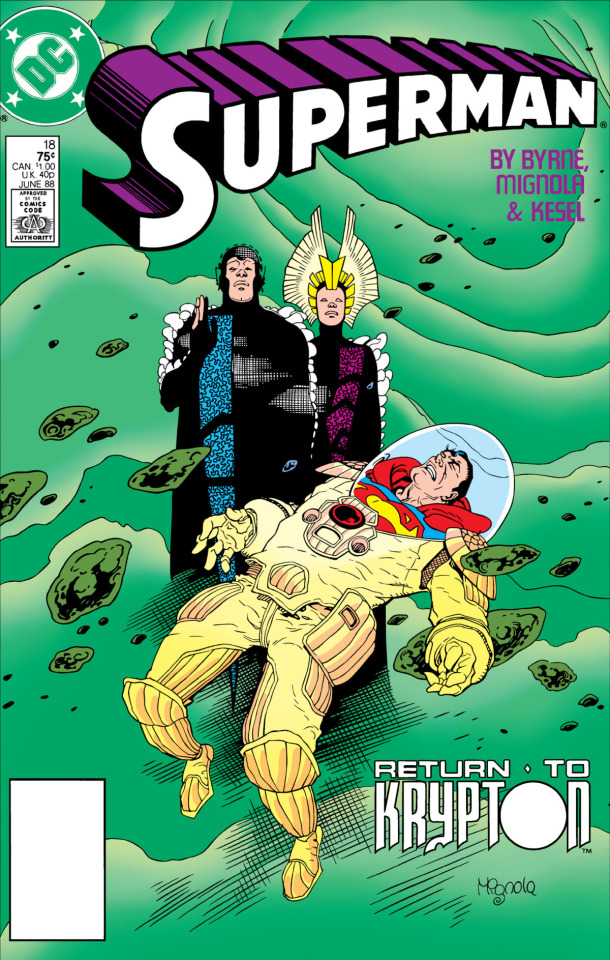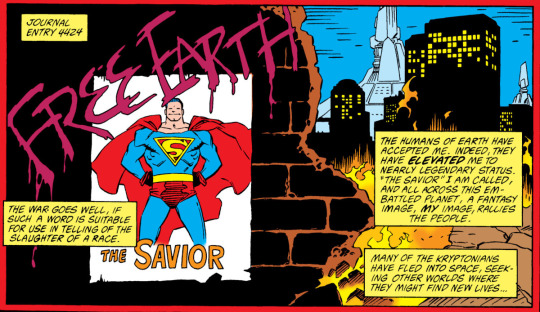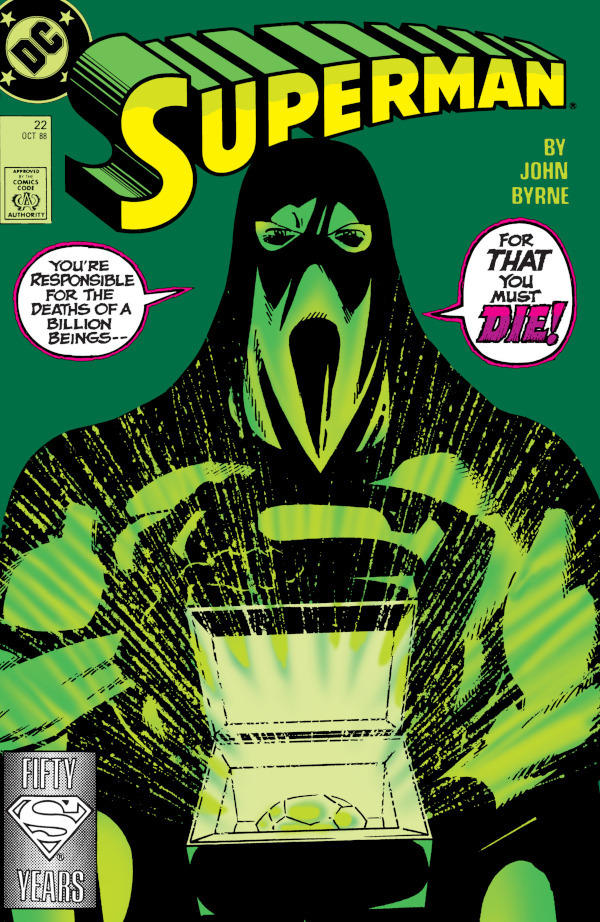#i'm still inclined to think world of krypton is worse
Text

June 1988. 1988 was an extremely ugly year at DC, marked by gratuitous brutality on nearly every front. Not content with his vile take on Krypton in the WORLD OF KRYPTON miniseries (which could be summarized as "sci-fi blood libel"), John Byrne took the time to explain unequivocally that the ugly nativist implications of MAN OF STEEL were no accident.
In this issue, illustrated by Mike Mignola and Karl Kesel, Superman returns to Krypton with the help of Hawkman and Hawkwoman, and finds that it's now a planet-shaped mass of highly radioactive Kryptonite debris. Determined to search for "some trace, some artifact remaining of the race that bred me," Superman borrows a Thanagarian battlesuit and ventures out into the debris field, where the overwhelming radiation causes him to hallucinate an alternate reality where Jor-El found a way for the people of Krypton to survive their world's destruction and emigrate to Earth. This fantasy is narrated in the first person by Jor-El (in the form of excerpts from an imaginary journal), presenting a horrifying, frankly fascistic vision of malevolent immigrants, evil mothers, and populist genocide.
If you've read MAN OF STEEL, much less WORLD OF KRYPTON, it will not surprise you to learn that Superman's fantasy of Kryptonian survival and emigration very quickly turns ugly. As Jor-El's imaginary journal narrates:

In pop culture, the alien invasion story typically represents the fear of the violence of settler colonialism coming home to roost in the imperial core, and you could hardly ask for a more textbook example than this: The refugees from Krypton begin (re)building their own civilization over inhabited human cities, while relegating humans to reservations or concentration camps. Such a fantasy also fuels the delusion of self-indigenization, where settlers appropriatively define themselves as indigenous to the lands they or their ancestors have stolen. This is of course primarily a white fantasy; while the post-reboot Superman books did introduce a few Black and Latino characters, note that there's not a single person of color visible among the humans being interned. Note also that Byrne takes the opportunity to restate the fascistic thesis presented in MAN OF STEEL — that Kryptonian culture is corrupt because Kryptonians have "lived all their lives in isolation, denying their physical beings" in favor of technology and modernity.
That's not all, though. For one, you'll notice that Jor-El also describes as suspect the decision of some of his fellow immigrants "to live apart … to keep themselves aloof from the citizenry of our adopted world"; he acknowledges that the settler colonialism is worse, but he regards cultural self-isolation as inherently bad in its own right. Also, note that the Kryptonians rename Metropolis "New Kandor." As Byrne was most certainly aware, in pre-Crisis Superman lore, Kandor was the former capital of Krypton, stolen and shrunk by Brainiac and later recovered by Superman, who kept the bottled city in his Fortress of Solitude until he was able to find a way to permanently enlarge it. Kandor was, fairly explicitly, a Kryptonian ghetto: a closed Kryptonian community with rigidly defined borders, delimited both physically and by a set of complicated rules about who could enter or leave (and how), within which Kryptonian culture continued more or less as it had for centuries. What Byrne is saying here is that such (literally) ghettoized communities are intrinsically suspicious — that the inability or unwillingness to assimilate is categorically indicative of malign intent. The only virtuous decision for an immigrant or refugee, then, is to choose total and unconditional assimilation, as Superman does at the end of MAN OF STEEL and Jor-El subsequently does here:

Moreover, it's not enough for Jor-El to simply choose to become an Earthman (and implicitly an American); he must also "stand against [his] own race." As the fantasy continues, Jor-El creates synthetic Kryptonite and kills thousands of Kryptonians, forcing many of the survivors to flee into space. Since all of this is a hallucination in Superman's head, the version of Jor-El here represents Superman essentially imagining himself in his father's place, but in case that wasn't clear enough:

Jor-El does not, so far as we're shown, actually don the Superman costume, but he has expressly taken on that role, which in this case means becoming an explicitly genocidal populist champion. This is not hyperbole: Jor-El "rallies the people" against the evil Kryptonian elite as he carries out "the slaughter of a race."
The final conversation between Jor-El and Lara in the first issue of MAN OF STEEL had painted Lara in a rather negative light; while Jor-El is valorized for his rejection of Kryptonian values, Lara recoils from a vision of the "savage" people of Earth and hopes that their son will show them "proper Kryptonian ways." The unsavory connotations of that conversation (to which Superman could not possibly have been privy) play out even more explicitly in the climax of this fantasy:

In short, Lara becomes the ultimate embodiment of almost everything bad about Byrne's reimagined Krypton. This plays almost like a throwback to the pop psychology of the 1950s and early 1960s (when Byrne was a child), which held that the maternal role had to be carefully regulated, since over-mothering could be just as psychologically damaging as maternal neglect. Perhaps the ultimate satirical exponent of that philosophy in pop culture terms is THE MANCHURIAN CANDIDATE, but it was a common piece of conventional wisdom, expressed here without irony. Lara's final act of villainy is the corruption of Kal-El himself, since in this fantasy, Jor-El has not been able to "save" their son from Kryptonian degeneracy. (Note also that Byrne restates once again his revisionist contention that Kal-El was conceived on Krypton, but actually born on Earth.)

While Jor-El is not wearing a Superman costume in these pages, he is wearing a costume of sorts, an outfit that evokes both Doc Savage and Hugo Danner, the hero of Philip Wylie's influential 1930 novel GLADIATOR, two pre-Superman supermen of the 1930s. Around the same time this issue was published, Roy Thomas was integrating GLADIATOR (which had entered the public domain) into DC continuity in YOUNG ALL-STARS, whose central character Arn "Iron" Munro was Hugo Danner's son. (Munro's usual outfit was a black T-shirt over white trousers, the inverse of what Jor-El wears here.)
Jor-El's scream of anguish marks Superman's return to consciousness, so the fantasy ends at this point, and the Hawks help Superman return to their ship. Superman then provides the following summation of what we've just seen:

Since Superman's fantasy was a hallucination induced by radiation poisoning, one could potentially shrug off its ugliness as just a bad dream, but Superman rejects that, saying, "I'm afraid my vision was accurate," at least in its moral and political implications.
Of course, the principal authorial intent here is to reject and dismiss the Superman continuity Byrne had recently erased, in particular the previous Kryptonian diaspora, but the thesis of this story is perfectly consistent with mainstream American, Canadian, and European attitudes on immigration: Any immigrants or refugees must assimilate, promptly and completely, and those who don't, for whatever reason, represent a dire threat to the polity that must be met with expulsion or annihilation. If the number and/or nature of the immigrants does not allow for prompt assimilation, lethal violence — up to and including genocide — is not only appropriate, but a moral imperative for the survival of the imperial state and/or the "white race" [sic]. There are many people in the real world who expressly believe that, so it's not necessarily surprising to see it expressed so bluntly in a Superman comic, but it is very ugly.
This story was unfortunately not the end of it, so far as Byrne and Superman were concerned. While the fantasy sequence here amounts to Superman picturing himself as his father, the heroically genocidal champion of an imagined reality, it is still just a fantasy, even within the context of the superhero comic narrative. It therefore leaves unanswered (at least for Byrne) the question of whether Superman would actually be willing to commit murder and/or genocide to protect the Earth from others of his kind.

Since Byrne had taken pains to ensure that there were no other living Kryptonians — the only other was the Superboy of the Pocket Universe created to reconcile MAN OF STEEL with the Legion of Super-Heroes, who was already dead — he was obliged to invent some for the purpose. About three months after this issue appeared, Byrne's final storyline (in SUPERMAN #21, ADVENTURES OF SUPERMAN #444, and SUPERMAN #22) introduced three facsimiles of pre-Crisis Phantom Zone villains in the Pocket Universe, whom Superman finally executes after they have completely depopulated the Pocket Universe's Earth (also conveniently ensuring that that world couldn't be used to provide any kind of end runs around post-Crisis continuity, and giving Byrne the opportunity to grind his heel on the earlier Superman mythos one more time).
With that story, the reactionary throughline Byrne had begun in MAN OF STEEL was complete, establishing not only that Superman was now a true-blue, American-born native hero, but also that he was willing to kill other Kryptonian survivors to defend his adoptive white Gentile American culture. "Yikes" doesn't begin to cover it, I'm afraid.
#comics#superman#john byrne#mike mignola#karl kesel#krypton#kryptonite#jor el#kryptonian diaspora#this is one of the most unpleasant superman stories ever#its politics are utterly rancid#i'm still inclined to think world of krypton is worse#but it's a different part of the same horrifying thesis#genocide cw#antisemitism cw#xenophobia cw
21 notes
·
View notes